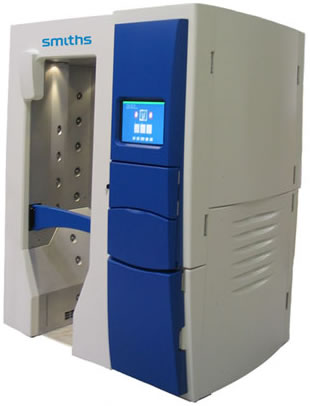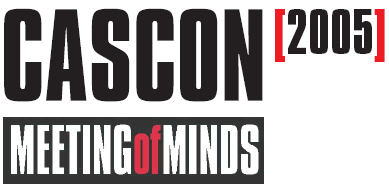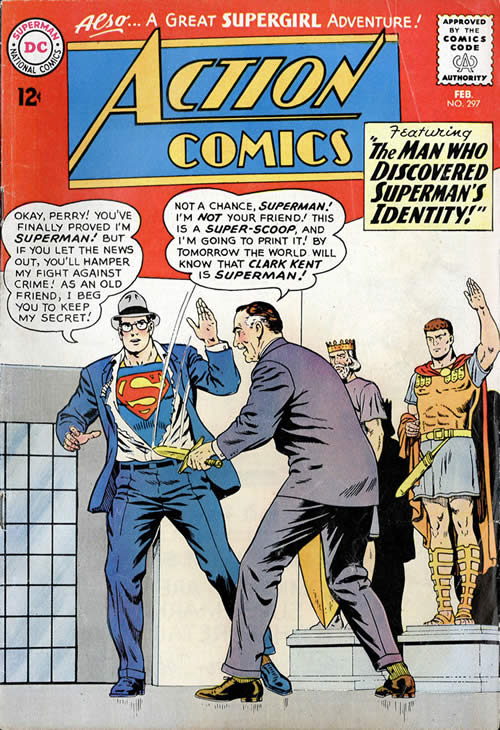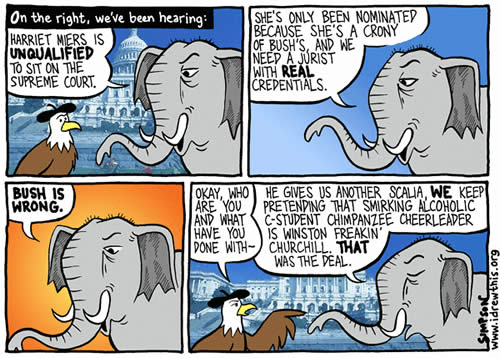One of my favourite bits of dialogue from a “Slappy Squirrel” segment of the old Animaniacs cartoon:
Bumpo (a young dog): Can I sniff you, Uncle Stinky?
Stinkbomb (an old dog): No! Don’t be weird.
It’s been a while since I last visited the CN Tower — it was probably
2001 when I last set foot inside the building. These days, I go only
when showing it to out-of-town family visitors, which we had on Thanksgiving
weekend. Wendy’s parents came up from Boston for a triple-occasion
weekend that covered my nephew Ryan’s christening, her birthday and
Canadian Thanksgiving. We had an extended family party on Sunday;
Monday night was for dinner at the Tower with her parents, my parents
and us.
I was surpised to see a row of three of these devices at the entrance to the hallway leading to elevators:

It’s the Ionscan Sentinel II Contraband Detection Portal, a device manufactured by Smiths Detection. They’re very Star Trek,
from outward appearance right down to the touch panels and female
female voice. Here’s what the Sentinel II does, according to the
promotional copy on the web site:
Only the SENTINEL offers true head-to-toe screening. Gentle puffs
of air dislodge any particles trapped on the body, hair, clothing and
shoes. These particles are then directed into the instrument for
analysis.
IONSCAN® technology combined with preconcentration technology
developed by Sandia National Laboratories allows for the high
throughput of screening up to 7 people per minute.
Trace amounts of more than 40 substances are detected and identified
in seconds. Results are displayed in an easy-to-understand fashion.
Should a detection be made, a digital camera is included to take a
photo of the person for easy identification.
It detects the following explosives:
- RDX
- PETN (a main ingredient of plastic explosives)
- TNT
- Semtex (notorious for being difficult to detect due to its “scentlessness”)
- NG (you probably know this better as nitroglycerin)
- “and others”
and the following drugs, listed with their stereotypically-associated subcultures:
- Cocaine (yuppies)
- Heroin (rock musicians)
- PCP (freaks and crazies)
- THC (hipsters, hippies, yuppies, rock musicians)
- Methamphetamine (bikers, rural working class)
- Ecstasy (ravers)
- “and others”
The scanning process is pretty quick. You walk into the portal and
stand on a spot designated by two footprint-shaped markers. A large
number of nozzles that look just like the air nozzles above the seats
in airplanes spray you with a few puffs of air. This process loosens
particulate matter on your clothes and body. This is followed by the
sound of a motor, which I assume powers an air intake pump, which draws
in the loosened particles for analysis. Based on the analysis, you are
then either free to go or quickly dragged off to the body cavity search
room.
The entire scanning process takes less than ten seconds, from entrance
to exit. The promotional copy boasts that it can scan 7 people a
minute, or 420 per hour. Three of these machines gives the CN Tower
checkpoint a total throughput of 1260/hour. This probably would’ve
exceeded the old throughput of the elevators, when there were only four
of them. Back then, you’d occasionally hear of people waiting for about
an hour for an elevator. There are now six elevators; two were added
when they moved to the the stairs to the central core, freeing up room
for more elevator shafts.
All of us save Dad went through the portal. Dad uses a walker, which is
too wide. He was directed to another area to the side of the portals,
where he was chemically analyzed the “old” way — the security guard
rubbed a gauze swab over some of his clothes and his walker and
placed it into a scanner.
Searching people for explosives before they enter a public building
isn’t a new thing. From the World Trade Center’s re-opening in the
mid-nineties until September 11, 2001, it was standard procedure to
undergo search before you could use the elevator, a procedure which
probably added ten minutes to your commute time if you worked there.
They were pretty through when I was last there in 1999; they even asked
me to open my accordion so they could inspect its innards. Terrorism is
partly about being splashy, and blowing up prominent and symbolic
buildings is high on the “splashy” list.
Getting them installed at the CN Tower is also good advertising for
Smiths Detection. It’s a prominent tourist attraction, and having the
Sentinel II prominently displayed at its entrance ensures that people
all from all over the world — or hey, a local blogger — will talk
about them.
In addition to the CN Tower, the Sentinel II has also been installed at “one of Canada’s major nuclear power facilities” (the press release doesn’t get any more specific).
I wonder why you don’t see more of these devices at airports. I suppose it’s still relatively new — JFK installed some late last year
and I’ve heard that they’re also in the Miami airport. I also suppose
that they’re quite expensive, and unlike other expensive airport
amenities, they’re not revenue generators.
(And ‘fess up: when it was time to buy smoke detectors for your apartment or house, did you buy top-of-the-line?)
Addendum:
Also of note: these things only detect explosives and drugs, and drugs,
in spite of what the US Government may tell you, aren’t part of the
terrorist arsenal (the bulk of their money probably comes from your
super unleaded purchases). They
don’t detect guns or knives — remember, the 9/11 terrorists used
boxcutters — and metal detectors can’t detect those newfangled ceramic
blades, such as those Kyocera kitchen knives Rob and Leslie gave to us as wedding presents.






